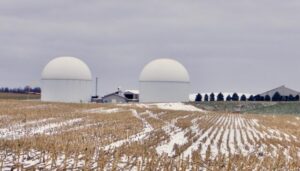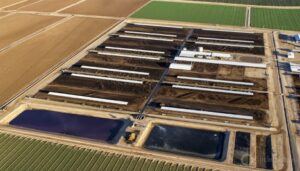Keith Schneider
- 2023

Fellowship Title:
- Confronting Agriculture’s Toxic Discharge
Fellowship Year:
- 2023

US push to turn farm manure into renewable energy draws concerns
AMES, IOWA – In a gathering that drew the attendance of both farmers and Wall Street financiers, US regulators joined with oil giant Chevron at a November conference here to promote what backers promise will be a monumental breakthrough – systemic changes that would turn polluting agricultural waste into a source of renewable energy that replaces fossil fuels and slows climate change. Speakers at the conference, which was hosted by Iowa State University and co-sponsored by the Environmental Protection Agency (EPA) and the US Department of Agriculture (USDA), assured attendees that the answers to agricultural and climate woes can be found in technology that already exists: Key, according to conference promoters, is the rapid expansion of large methane biodigesters, which capture manure waste from the nation’s cattle, hog and poultry operations and convert it into a harvest of both public and private riches. Water and air would be cleaner and farmers could see billions of dollars in new farm income, among other benefits, according to backers. “It can provide a substantial portion of global energy

Agriculture Evades Accountability, Responsibility for America’s Worst Water Pollution
Law, Policy, and Power Insulate Crop and Livestock Producers In 1990, following intensive field trials, a respected agronomist at Iowa State University named Fred Blackmer formally introduced an inexpensive tool to accurately measure how much nitrogen farmers actually require to produce abundant harvests of corn, the most heavily fertilized crop. Driven by concerns about rising production costs and increasing water pollution, Blackmer’s “late spring nitrate test” was stunningly simple in concept. His test focused on one essential data point: the optimum amount of nitrogen in soil to grow the most corn. His science showed that optimum soil concentration is 20 to 25 parts per million. The headwaters of the Cedar River, which flows 338 miles from southern Minnesota through Iowa, are choked by algae, the result of excess farm nutrients running off farm fields and from large swine production facilities. Blackmer developed three steps to get there. First, he took soil samples from farm fields, which typically showed background nitrogen levels at under 10 parts per million. Second, he developed calculations to add fertilizer in

New U.S. Climate Law Could Make Midwest Water Contamination Worse
Billions in clean energy incentives rely on raw materials from polluting corn and livestock. This report was made possible by an investigative reporting fellowship awarded by the Alicia Patterson Foundation. A version of this article was co-published by Circle of Blue, The New Lede and The Guardian. February 8, 2023 President Biden, U.S. environmental organizations, and climate activists were appropriately enthused last summer when Democrats passed the Inflation Reduction Act. Embedded in the new statute are more than $140 billion in direct payments and tax incentives for renewable fuels and cleaner electrical generation to help reduce greenhouse gas emissions 40 percent below 2005 levels by the end of the decade. The statute also includes $19.5 billion for the Department of Agriculture’s new “climate smart” crop production practices. In the give and take of opinion about the climate provisions of the Inflation Reduction Act, the consensus is that the social benefits of curbing the Earth’s warming easily exceed the financial and social costs. Yet viewed from the frontlines of a water quality emergency that has unfolded
